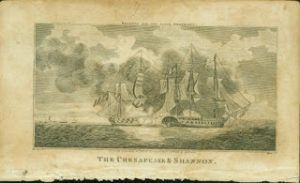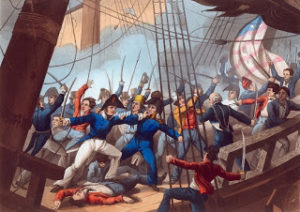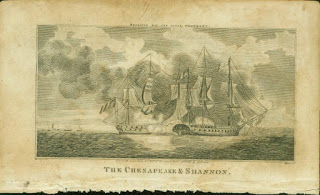The first day of June 1813 dawned clear and warm over Boston Harbor. Below Fort Independence, the US frigate Chesapeake lay at anchor. On deck, her crew hurriedly cleaned up from the driving rain storm of the night before. As they coiled down braces and halyards, Captain James Lawrence surveyed the scene from the quarterdeck. He’d only been in command for eleven days, his officers were young and inexperienced, and he’d not yet tested the mettle of the common seamen. Were they prepared to sail their ship to victory?
As Lawrence contemplated the preparedness of his crew, a British captain a few miles away had the same thoughts. Off Boston Light, the British frigate Shannon tacked back and forth, keeping watch on Boston Harbor and the American vessel. Captain Philip Broke’s crew had been aboard for years, and he’d relentlessly trained them in the art of gunnery. Still, as he watched the big American frigate get underway and stand down President Roads, he must have wondered if his men were ready to take on one of the United States’ seemingly invincible ships.
About 12:30 PM, Chesapeake’s sails spread to catch the warm land breeze and she stood down the harbor toward the waiting British ship. As the Americans came out, a flotilla of yachts and other boats from Boston accompanied them, eager to witness the contest.
The captains brought their ships into action like two knights errant at a joust. Shannon hove to, barely moving through the calm sea. Chesapeake spread every sail to take advantage of the wind, and as the afternoon progressed, closed the gap between the ships. A white flag, bearing the motto “Free Trade and Sailors Rights” fluttered from the fore royal mast. At 5:25, the Americans reduced sail and steered right for the British. There was no maneuvering. Twenty-five minutes later Chesapeake ranged abreast of Shannon, and both sides began to fire furiously. Broke’s men, trained to fire by command, systematically demolished Chesapeake’s hull, sweeping her decks and killing and wounding all the officers there. As Chesapeake’s helmsmen fell, their ship turned into the wind, lost way, and drifted aboard Shannon. The British crew quickly lashed the two ships together and prepared to board.

On board the American vessel, chaos reigned. The initial British fire mortally wounded Captain Lawrence. As sailors carried him to the surgeon, he continued to give orders. According to Surgeon’s Mate James Dix, “he then ordered me to go to the deck and tell the men to fire faster and not give up the ship.”1 The US Marines, normally the first line of defense against enemy boarders, suffered severely in the opening minutes of the battle. Clustered along the Chesapeake’s gangways in the waist, First Lieutenant James Broom and eleven privates lay dead, cut down by Shannon’s 12 lb carronade fired at point blank range and a volley of musketry from the Royal Marines.

The Americans left standing on the spar deck cleared out in a hurry. Most of the seamen scurried down the main and fore hatches to escape the fury of the British boarders. Nevertheless, the surviving US Marines stood fast, first clustered around the main mast, then beat a fighting retreat to the forecastle.
As Shannon’s captain of the maintop boarded over the British ship’s starboard gangway, “An American Serjeant of Marines [Sergeant John Twiss or William Harris] fired at me but struck the next man in the throat. I immediately gave chase to him but he escaped me by running through the bow port into the main deck.”2
With that, all resistance ceased. In less than fifteen minutes, Shannon had captured Chesapeake. The long string of American victories was broken.
During a day of disgrace and disaster, the United States Marine Corps had proved its worth. Of the forty three Marines who sailed from Boston on Chesapeake, twelve were killed outright in the action and twenty more fell wounded.
Why did the Marines stand and fight, when all the American seamen ran from their guns?
Fourteen of Chesapeake’s Marine guard had served on Constitution during either the Guerriere or Java battle, or both. They were veterans and they knew each other. As comrades in arms, they watched each other’s backs, and they’d just seen a third of their brethren cut down before them.
Four of Constitution’s former Marines died in the action, including Privates John German, James Traenor, Jacob Preston, and Redmond Barry. They were a perfect cross section of the sort of men who made up the early Corps. German was a former farmer born in Delaware and enlisted at Philadelphia in January 1812. He joined Constitution when he was twenty-seven, just before the declaration of war, and came through the ship’s two battles without a scratch. Thirty-one year old blacksmith James Traenor hailed from Ireland and enlisted in the Corps at New York in 1809. He too fought in the actions against Guerriere and Java. Preston, a twenty-seven year old former soldier from Pennsylvania, joined the Marines in 1810 and served on Constitution the same year before being stationed at the Philadelphia Navy Yard. He rejoined the ship in June 1812 at the Washington Navy Yard. Barry, a thirty-two year old laborer from Cork, Ireland, enlisted at Frederick, MD in 1811 and came on board on the first of July 1812. All had been transferred to Chesapeake scarcely two months before.
Seven more privates who had served on Constitution fell wounded: James Brown, Joseph Twiss, Samuel Jackson, John Johnson, Thomas Johnson, George Clyne, John Brady. Of these, Brown, Brady, and Clyne received severe wounds, but luckily all seven survived long enough to be exchanged and sent home to Boston. As they recuperated at the Marine Hospital and at the Navy Yard Barracks, they must have told and retold all that befell them on the fateful first of June.
1 “Proceedings of a General Court Martial on board the Frigate United States in cases of Lieut. W.S. Cox, Mid. James W. Dulany, Henry P. Fleshman, Wm. Brown and J. Russell, New London 15 April 1814.” Records of General Courts-Martial and Courts of Inquiry of the Navy Department, RG 125, NA.
2 John Collier, Capt. of the Maintop, to Capt. R.H. King, RN, 29 Nov. 1841, in H.F. Pullen, The Shannon and the Chesapeake (Toronto: McClelland and Stewart, Ltd., 1970), 92.
2 John Collier, Capt. of the Maintop, to Capt. R.H. King, RN, 29 Nov. 1841, in H.F. Pullen, The Shannon and the Chesapeake (Toronto: McClelland and Stewart, Ltd., 1970), 92.
The Author(s)
Matthew Brenckle
Research Historian, USS Constitution Museum
Matthew Brenckle was the Research Historian at the USS Constitution Museum from 2006 to 2016.
